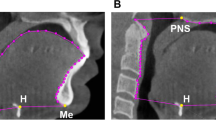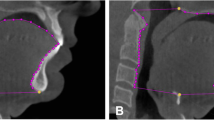Abstract
Purpose
Positional change during sleep influences upper airway patency. However, few studies have used imaging techniques to demonstrate the change. This study aims to determine the effect of positional change on the upper airway space.
Methods
A total of 118 subjects with sleep breathing disorders were analyzed. Participants underwent upper airway CT scans in the supine and lateral decubitus positions (right and left). They were divided into non-obstructive sleep apnea (n = 28) and obstructive sleep apnea (n = 90) groups. We measured the minimal cross-sectional area of the retropalatal/retroglossal spaces and compared the differences of those two spaces in the supine and lateral positions. CT was performed while patients were awake.
Results
The minimal cross-sectional area in the OSA group was significantly smaller than non-OSA group in both supine (median[interquartile range], 8.3[0.0–25.1] vs 22.2[1.0–39.6]; P = 0.018) and lateral decubitus positions (5.2[0.0–16.9] vs 21.3[6.1–38.4]; P = 0.002). As the body position of OSA patients shifted from supine to lateral, the retroglossal space increased significantly (67.3[25.1–116.3] vs 93.3[43.4–160.1]; P < 0.001). However, there was no significant difference in the retropalatal space between the supine and lateral decubitus positions.
Conclusions
Positional change from the supine to lateral decubitus position expands the upper airway lumen, especially the retroglossal space. Positional OSA may be related to anatomical change of the upper airway lumen based on body position.



Similar content being viewed by others
References
Epstein LJ, Kristo D, Strollo PJ Jr, Friedman N, Malhotra A, Patil SP, Ramar K, Rogers R, Schwab RJ, Weaver EM, Weinstein MD (2009) Clinical guideline for the evaluation, management and long-term care of obstructive sleep apnea in adults. J Clin Sleep Med 5(3):263–276
Cartwright RD (1984) Effect of sleep position on sleep apnea severity. Sleep 7(2):110–114
Ravesloot MJL, White D, Heinzer R, Oksenberg A, Pépin JL (2017) Efficacy of the new generation of devices for positional therapy for patients with positional obstructive sleep apnea: a systematic review of the literature and meta-analysis. J Clin Sleep Med 13:813–824
Mador MJ, Kufel TJ, Magalang UJ, Rajesh SK, Watwe V, Grant BJ (2005) Prevalence of positional sleep apnea in patients undergoing polysomnography. Chest 128(4):2130–2137
Weaver TE, Grunstein RR (2008) Adherence to continuous positive airway pressure therapy. Proc Am Thorac Soc 5(2):173–178
Chai-Coetzer CL, Antic NA, Rowland LS, Reed RL, Esterman A, Catcheside PG, Eckermann S, Vowles N, Williams H, Dunn S, McEvoy RD (2013) Primary care vs specialist sleep center management of obstructive sleep apnea and daytime sleepiness and quality of life: a randomized trial. JAMA 309(10):997–1004
Barnes H, Edwards BA, Joosten SA, Naughton MT, Hamilton GS, Dabscheck E (2017) Positional modification techniques for supine obstructive sleep apnea: a systematic review and meta-analysis. Sleep Med Rev 36:107–115
Permut I, Diaz-Abad M, Chatila W, Crocetti J, Gaughan JP, D'Alonzo GE, Krachman SL (2010) Comparison of positional therapy to CPAP in patients with positional obstructive sleep apnea. J Clin Sleep Med 6(3):238–243
Barkdull GC, Kohl CA, Patel M, Davidson TM (2008) Computed tomography imaging of patients with obstructive sleep apnea. Laryngoscope 118(8):1486–1492
Pevernagie DA, Stanson AW, Sheedy PF 2nd., Daniels BK, Shepard JW Jr (1995) Effects of body position on the upper airway of patients with obstructive sleep apnea. Am J Respir Crit Care Med 152(1):179–185
Iber C, Ancoli-Israel S, Chesson A, Quan SF (2007) The AASM manual for the scoring of sleep and associated events: rules, terminology and technical specifications. Terminology and technical specifications. AASM. American Academy of Sleep Medicine, U.S.A, Westchester
Oksenberg A, Silverberg DS (1998) The effect of body posture on sleep-related breathing disorders: facts and therapeutic implications. Sleep Med Rev 2(3):139–162
Ciscar MA, Juan G, Martinez V, Ramon M, Lloret T, Minguez J, Armengot M, Marin J, Basterra J (2001) Magnetic resonance imaging of the pharynx in OSA patients and healthy subjects. Eur Respir J 17(1):79–86
Victores AJ, Hamblin J, Gilbert J, Switzer C, Takashima M (2014) Usefulness of sleep endoscopy in predicting positional obstructive sleep apnea. Otolaryngol Head Neck Surg 150(3):487–493
Ogawa T, Enciso R, Shintaku WH, Clark GT (2007) Evaluation of cross-section airway configuration of obstructive sleep apnea. Oral Surg Oral Med Oral Pathol Oral Radiol Endod 103(1):102–108
Yu CC, Hsiao HD, Tseng TI, Lee LC, Yao CM, Chen NH, Wang CJ, Chen YR (2012) Computational fluid dynamics study of the inspiratory upper airway and clinical severity of obstructive sleep apnea. J Craniofac Surg 23(2):401–405
Rama AN, Tekwani SH, Kushida CA (2002) Sites of obstruction in obstructive sleep apnea. CHEST J 122(4):1139–1147
Vgontzas AN, Bixler EO, Chrousos GP (2005) Sleep apnea is a manifestation of the metabolic syndrome. Sleep Med Rev 9(3):211–224
Lam B, Ip M, Tench E, Ryan C (2005) Craniofacial profile in Asian and white subjects with obstructive sleep apnoea. Thorax 60(6):504–510
Oksenberg A, Khamaysi I, Silverberg DS, Tarasiuk A (2000) Association of body position with severity of apneic events in patients with severe nonpositional obstructive sleep apnea. Chest 118(4):1018–1024
Kim EJ, Choi JH, Kim YS, Kim TH, Lee SH, Lee HM, Shin C, Lee SH (2011) Upper airway changes in severe obstructive sleep apnea: upper airway length and volumetric analyses using 3D MDCT. Acta Otolaryngol 131(5):527–532
Cosentini T, Le Donne R, Mancini D, Colavita N (2004) Magnetic resonance imaging of the upper airway in obstructive sleep apnea. Radiol Med 108(4):404–416
Deyoung PN, Bakker JP, Sands SA, Batool-Anwar S, Connolly JG, Butler JP, Malhotra A (2013) Acoustic pharyngometry measurement of minimal cross-sectional airway area is a significant independent predictor of moderate-to-severe obstructive sleep apnea. J Clin Sleep Med 9(11):1161–1164
Lee CH, Jung HJ, Lee WH, Rhee CS, Yoon IY, Yun PY, Kim JW (2012) The effect of positional dependency on outcomes of treatment with a mandibular advancement device. Arch Otolaryngol Head Neck Surg 138(5):479–483
Mo JH, Lee CH, Rhee CS et al (2011) Positional dependency in Asian patients with obstructive sleep apnea and its implication for hypertension. Arch Otolaryngol Head Neck Surg 137:786–790
Funding
This research was supported by the Basic Science Research Program through the National Research Foundation of Korea (NRF), funded by the Ministry of Education of the Korean government (NRF-2017R1D1A1B03028964).
Author information
Authors and Affiliations
Corresponding author
Ethics declarations
Conflict of interest
The authors declare that they have no conflicts of interest.
Informed consent
Informed consent was obtained from all individual participants included in the study.
Ethical approval
The institutional review board reviewed and approved the research protocol.
Additional information
Publisher’s note
Springer Nature remains neutral with regard to jurisdictional claims in published maps and institutional affiliations.
Rights and permissions
About this article
Cite this article
Kim, W.Y., Hong, SN., Yang, S.K. et al. The effect of body position on airway patency in obstructive sleep apnea: CT imaging analysis. Sleep Breath 23, 911–916 (2019). https://doi.org/10.1007/s11325-019-01863-x
Received:
Revised:
Accepted:
Published:
Issue Date:
DOI: https://doi.org/10.1007/s11325-019-01863-x




